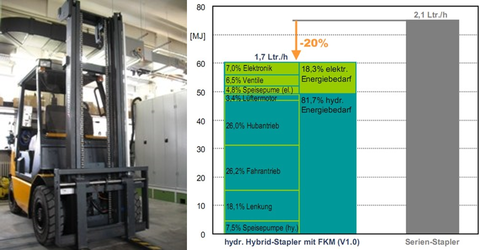Hybrid forklift
Forklift with hydraulic hybrid drive
Contact: Frank Hänel
Starting point and concept:
The thermohydraulic free piston machine (FKM) is the result of many years of research at the chair. It directly generates hydraulic power from diesel combustion. The machine works on the constant pressure network and knows only two operating states: ON and OFF. This makes it ideal for use in a hybrid drive system. The consumers use the (rechargeable) hydraulic accumulators. The FKM maintains their pressure. So it is a serial hybrid powertrain. The high-performance consumer drive and linear actuator are operated as required without throttle losses by adjusting units. This enables the recuperation of braking energy.
The smaller consumer steering and tilting device are traditionally operated using loss control. There is no possibility of energy recovery here and the good controllability remains. Since the FKM has no rotating parts and the technology for generating electrical energy from linear movements is currently not suitable for mobile use, hydraulic power must be converted into electrical power to supply the electrical consumers (e.g. valves) and the electronics. For this purpose, a hydraulic motor is supposed to drive a generator. This arrangement also serves to provide initial conditions. The FKM requires hydraulic high pressure to work. With the currently installed components, the provision of electrical energy is not possible. The conversion chain has an overall efficiency of approx. 0.3. The supply of the electrics and electronics is therefore secured with batteries. This share is reflected in the energy balance. Deployment efficiency is estimated at 0.15.
Measurements with the fully functional prototype were carried out in a load cycle similar to VDI 2198. For comparison, the work cycle was carried out with a similar series forklift (also Jungheinrich) and the fuel consumption of both machines was determined.
Result:
The hybrid system saved 20% fuel straight away! The reduction in consumption can be attributed almost exclusively to the start-stop operation of the free-piston machine. The average duty cycle is approx. 39%. During this time the machine runs at the design point. Inefficient part-load operation is avoided. The measured values suggest further savings potential.

